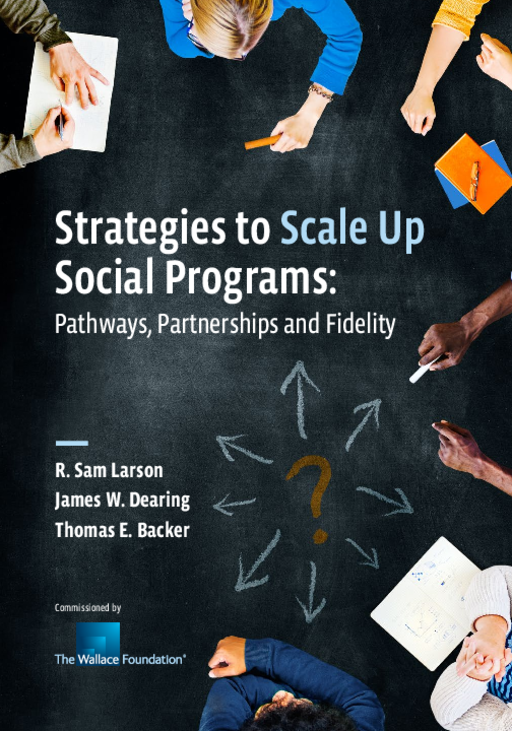Breadcrumb
- Wallace
- Reports
- Strategies To Scale Up Social Pr...
Strategies to Scale Up Social Programs

Summary
How we did this
The researchers selected the 45 programs based on the advice of experts and their own database searches. They read and coded close to 500 documents related to the organizations and then conducted interviews with 100 program leaders.
This study of 45 social programs takes a broad look at efforts that were able to extend their reach through partnerships. It finds some common patterns among the programs.
The selected nonprofit programs came with evidence of effectiveness and could demonstrate that they'd had some success in scaling up. Researchers also focused on programs that chose to work with partners. The goal, therefore, was not to create a representative sample of all social programs that have sought to scale up, but rather to draw from those who had expressed interest in doing so.
The areas of work spanned the education, youth development, and health sectors. Projects were as varied as safe playgrounds, food kitchens, and job placement for former prisoners.
Those behind the 45 scale-ups—the “lead partners”—shared three fundamental decisions: which expansion approach (or, pathway) to take, what partners to choose, and how much fidelity to the program model to demand.
On pathways, the focus was on a trio of types, and the choices went hand in hand with the decision on which partner to work with:
- Branching pathways, which are similar to businesses opening branch sites as extensions of the central office. The choice typically means slower growth, because much responsibility remains centralized with the lead partner, but it offers a high level of control in delivery.
- Affiliate pathways, which are more like franchises, with basic controls remaining with the lead partner. Affiliate partners are independent organizations, often operating under contracts.
- Distribution network pathways, similar to supply chain business arrangements, where the lead partner provides the content (the “product”) and the network partners handle the distribution. Network partners typically were regional or national organizations with wide reach in membership, such as the YMCA of the USA and AARP.
The third major decision involved the lead partner’s position on fidelity, or how true they remained to their original model. Some looked for complete adherence to their program models. Others let their partners customize elements to meet local needs and preferences. The aim was to balance fidelity and flexibility to address issues such as affordability and audience variety in addition to program quality.
The report emphasizes that the scale-ups are a work in progress, as partners continue to assess their successes and keep up with changing social and funding circumstances.

By scaling up we mean a process for significantly increasing the number of sustained implementations of a successful program, thereby serving more people with comparable benefits.
Key Takeaways
- Programs choosing to scale up through partnerships have three primary strategic choices:
- the pathways they choose for program delivery
- the partners they choose
- how faithful they remain to their original design in running their program.
- A few common pathways for program delivery include branching pathways (gradual establishment in new locations); affiliate pathways (partnering with organizations in new locations); and distribution network pathways (collaborating with established networks for rapid distribution).
- Partners in social program scaling can take on multiple roles, but there is usually one "lead partner" who brings together funders, community organizations, and others to run and continue to scale the program.
- Partnerships may shift their "program fidelity," or how closely they follow their original pathway. For example, the report notes, a program designed for third graders might actually work better for fifth graders, so they might want to adapt it.
Materials & Downloads
What We Don't Know
- What might scaling up look like for organizations who were new to the concept or who had never tried to work wither partners at this level before?
- What strategies beyond partnerships, pathways, and fidelity to the program design might also have an effect on successful scale-up efforts?

